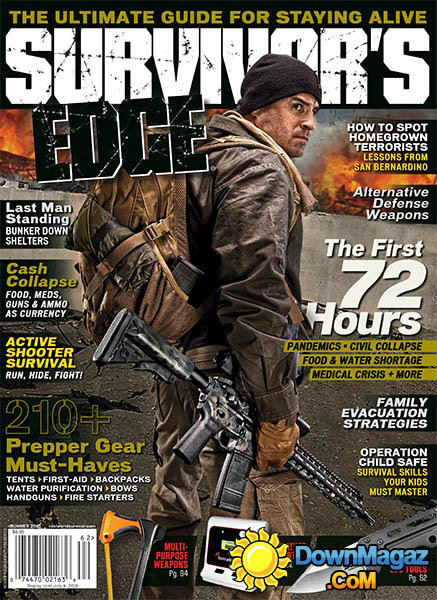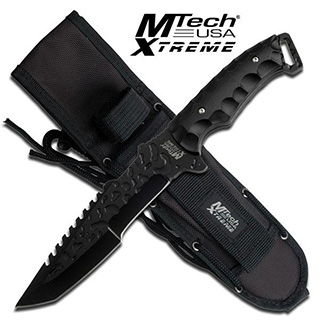
Although being prepared generally means having the best means of defence available, there may be situations where you need a more primitive means of defence. The spear was historically used from the earliest times and even into the modern era in some places, and it still has its place when you’re stuck in the wilderness and in need of a weapon. Of course you can just use a knife or some rocks to shape a stick into a spearpoint, but a little bit of hardening by a campfire can drastically improve the durability and performance of your spear, making it a highly recommended step.
How to create your spear
A spear is one of the simplest weapons possible, but for proper fire hardening you will want to use good, solid wood that is durable and hard. Oak or ash wood are both excellent candidates, and you should cut down a fresh and fairly straight branch for your spear. In this case the moisture in the wood is actually to your benefit, so if you are unable to find a suitable branch still growing on the tree, be sure to soak any dead wood in water thoroughly before taking the time to shape and harden it.
Once you have the proper material, you may find it easier to strip the bark from the tip although it is not required. Once you can see what you’re doing, perform the first pass of fire hardening. This is done by alternating between placing the wood above the flames and burying it for a few moments in the heat of the coals. You should constantly rotate it in order to spread the heat appropriately, and make absolutely sure that you only heat up the wood rather than burning it. Burning wood turns it into charcoal which is brittle and worthless for a spearpoint, and you just want the wood to harden as it dries and the fresh sap inside crystalizes. The tip will turn black, but it should still have the full strength of wood once it is done with the first pass. To ensure you’re doing it right, stab the hardened end into a rock or other hard surface. If the end crumbles and breaks apart you burned it into charcoal, but if it remains intact without breaking down you probably have a nice hardened end to work with.
Taking your new hardened end, begin shaping the wood into a spearpoint using whatever design you wish. Fishing spears tend to have barbs to hold the fish, while self-defense spears tend to be one single hardened point. Regardless of design you will probably need to harden the point at least twice more: once when you have the rough shape of the tip formed from the hardened end and again once you have the final sharpened point. So long as you don’t turn the wood into charcoal it can be hardened several times as you go through the process and the number of times needed will vary depending on the wood you use, the humidity in the air and a variety of other factors. It is important to experiment and craft several spears even in an emergency, since the force of impact can easily break even a well-made weapon.
Optionally, you can also harden the rest of the spear if you wish once the tip has been completed. Some argue it helps improve durability while others feel that having some flexibility in the wood is more desirable so the choice is up to you. I wouldn’t worry about the weight of the moist handle of the wood unless your spear is particularly long, since fire-hardened tips are not really suitable for throwing.
Why craft a spear?
Let’s assume that you have a knife or even a hatchet or axe on hand to protect yourself, so why would you want a spear? Spears can be better for a variety of reasons, including:
- Disposability. Aside from the time spent preparing the spear you won’t lose much if it breaks in half when you stab a dear or if you trip and drop it down a chasm. It also keeps you from wearing down your metal tools over time.
- Intimidation. A knife is dangerous, but most knives don’t exactly look threatening and are rather small. A spear is large and wicked looking particularly with a black fire-hardened tip on it, and it can be scary to other people and even animals.
- Ease of creation. A few hours with a sharp rock and a green piece of wood will make a spear, so it doesn’t require a lot of technical skill or woodscraftiness to find the proper materials. Short of being stranded in a desert you should be able to find at least one tree with suitable branches for your work.
- Utility. A spear can be used for hunting, fishing, as a walking/fighting staff, and in a worst case scenario you can break it down and use it for firewood.
- Deadliness. Spears have been used to bring down everything from a rabbit or squirrel to elephants, so there aren’t many threats that are immune to a good jab from that sharp tip. Depending on the design of the head, you can add barbs that enlarge wounds, penetrate thick hides/clothing, or even coat it in poison.
- Easy to use. A spear is one of the simplest weapons to use, since it boils down to “stick the pointy end in whatever you want to kill”. It also makes good use of your fight-or-flight response since the increased strength can be used to stab all the harder.
- The skill transfers over to other defences. Learning to make a spear isn’t all that different from learning how to build punji stakes or any other defence involving pointed sticks. Mastering the art of hardening a spear over a fire can be used to improve your traps as well, making them more potent.
A spear is easy to make, easy to use, and the materials are literally growing out of the ground. Make sure you know how to craft one of these makeshift weapons, just in case.
Your Thoughts?
Would you use a spear for defence? Are there any other design tips you would include? Let us know in the comments below!



